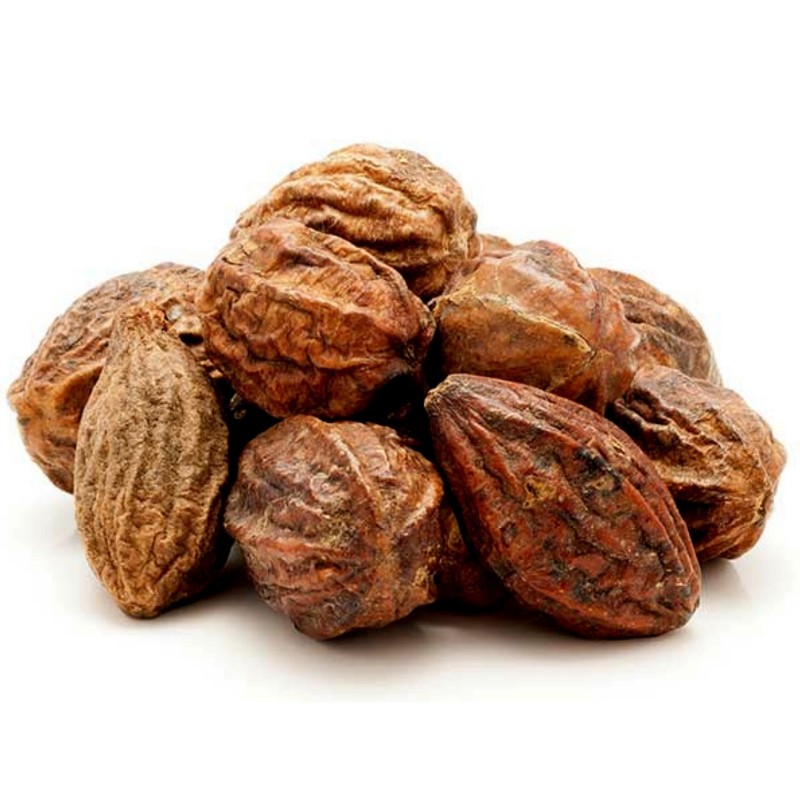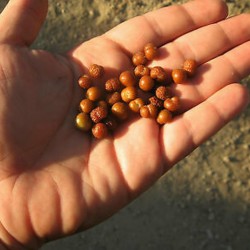

Προϊόν με μειωμένη τιμή χρόνου

Άγρια σταφίδα σπόρων...
- -0,01 €






Thailand Recognized as the King of Herbs. Because the effect of the removal of toxins from the body and treat many diseases. The same can also be healthy. And repair of the body. Terminalia chebula, also known as haritaki fruit and He Zi herb, is a common herb used in
Thailand Recognized as the King of Herbs. Because the effect of the removal of toxins from the body and treat many diseases. The same can also be healthy. And repair of the body.
Terminalia chebula, also known as haritaki fruit and He Zi herb, is a common herb used in Traditional Chinese medicine, Tibetan medicine, and Ayurveda medicine. It has had very good reviews from different alternative medicine genres, especially in Tibetan medicine, in which it is called as the King. And related statistical analysis showed that its frequency of utilization in Tibetan medicine is higher than that of Gan Cao (Licorice Root) in TCM. That’s to say, almost all Tibetan herbal formulas include this herb. It is native to India, Burma and other countries and was introduced to China as an astringent before the Tang Dynasty, according to Tang Ben Cao (Tang Materia Medica), a revised text compiled in 657-659 A.D.
Medicinally it refers to the dried ripe fruits of Terminalia chebula Retz. or Terminalia chebula Retz. var. tomentella Kurt., plants that belongs to the family of Combretaceae. Therefore, its common names include Myrobalan fruit, fructus chebulae, medicine terminalia fruit, chebula fruit, fructus terminaliae chebulae, Sheng He Li Le, terminalia chebulae fructus, Ke Zi, Sheng He Zi Rou, fruit of medicine terminalia, haritaki fruit, chebulic myrobalan, and more.
Its plant is a large deciduous tree, and often reaches 20 to 30 meters. Leaves are alternate or nearly opposite, ovate or elliptic, 7 to 2cm long, 3 to 15cm wide, with short pointed apex, obtuse or rounded base, entire margin, and bald clean sides. Spica grows on the top of branches or leaf axil. Flowers are bisexual and yellow. Drupe is obovate or oval, 2.5 to 4.5cm long, green when young, tan when ripe, and with smooth surface and 5 edges when dried. Seed is 1. And it usually flowers from June to August and fruits from August to October. The habitat and distribution covers roadsides and areas near villages. It originates in India, Burma and other places. In China, it mainly grows in Tibet, Yunnan, Guangdong, and Guangxi.
Key chemical constituents include 23.60% to 37.36% tannin, triterpenoids, sennoside A, chebulin, tannase, polyphenol oxidase, ascorbic acid enzyme and so on. And tannin mainly contains chebulinic acid, chebulagic acid, corilagin, terchebulin, punicalagin, terflavin A, terchebin, glucogallin, gallic acid, and so on. In addition, triterpenoids mainly contains terminoic acid, chebupentol, shikimic acid, dehydroshikimic acid, and more.
Terminalia chebula benefits
As what mentioned before, it is one of the most common Chinese herbs and was known as the King in the medical classic of Tibetan Pharmaceutical Science – Jing Zhu Ben Cao (Tibetan title: Shel. Gong Shel Phreng). As a matter of fact, its health benefits have been the major subject of Tibetan medicine and it has become a symbol of Tibetan medicine thanks to its widespread medicinal uses. What’s more, in Tibetan medicine this herb is considered with all the merits, namely six flavors, eight properties, three processing tastes, and seventeen efficiency, that treat a variety of diseases. In fact, today because of its high medicinal value and properties, terminalia chebula bark and fruit have been made into tea, fruit extract, oil, supplement, and tincture for hair, lyme disease, skin care, cancer, cystic fibrosis, diabetes, weight loss, vitiligo, and so on. So, what is the explanation in its pharmacology? Now let’s take a close look at it.
Modern pharmacological actions of chebula fruit
1. Its tannin has astringent, antidiarrheal effect;
2. In addition to tannin, it also contains lapactic composition, which has the similar effect available on Da Huang (Rhubarb);
3. Its 100% decoction works to a variety of Shigella and has strong effect on Pseudomonas aeruginosa and diphtheria bacilli. Besides, it inhibits Staphylococcus aureus, Escherichia coli, pneumococcus, hemolytic streptococcus, Proteus, and Salmonella typhimurium;
4. Its alcohol extract with hydrochloric acid and ether has stronger antifungal and antimicrobial activity;
5. Cardiotonic effect shows on the extract of ethyl acetate, methyl ethyl ketone, n-butanol and water and large dose of benzene and chloroform extract;
5. The active ingredient of chebulin, extracted from dried fruits with 80% ethanol, has papaverine-like spasmolysis on smooth muscle.
Proven herbal remedies on medicine terminalia fruit
From the description of Chinese Materia Medica, it is bitter and sour in flavor and astringent and neutral in properties. It goes to three meridians of lung, large intestine, and stomach. Vital functions include astringing the lung and intestine, descending qi, and relieving sore throat. Chief terminalia chebula uses and indications are chronic diarrhea, chronic dysentery, prolapse of the anus, wheezing, expectoration, and aphonia caused by chronic cough. Recommended terminalia chebula dosage is from 3 to 6 grams in decoction, pills or powder.
1. He Zi Yin. This formula, from Ji sheng fang (Formulas to Aid the Living), is exclusively for the failure of uttering a word due to chronic cough. Other three herbal ingredients are Xing Ren (Apricot Seed), Tong Cao (Rice Paper Pith), and Sheng Jiang (Fresh Ginger Rhizome).
2. He Zi Tang. This prescription, from Tai Ping Sheng Hui Fang (Taiping Holy Prescriptions for Universal Relief), is mainly design for aphonia. Other three herbs are Jie Geng (Balloon Flower Rhizome), Gan Cao (Licorice Root), and fresh lad urine.
3. He Li Le San. This recipe, from Sheng Hui Fang, is usually used for chronic diarrhea in the elderly. The other herb is Bai Fan (alum).
4. He Li Le San. This formula, from Jin Gui Yao Lue (Essential Prescriptions of the Golden Coffer), uses this herb alone as astringent to relieve diarrhea.
5. He Zi Pi San. This prescription, from Lan Shi Mi Zang (The Secret Treasury of the Orchid Chamber), is primarily made for chronic rectocele. Other three herbs include Yu Mi Ke (Pericarpium Papaveris), Ju Pi (orange peel), and Gan Jiang (Dried Ginger Root).
Terminalia chebula side effects and contraindications
So far no clearly recognized drug interactions about terminalia chebula fruit were reported. And generally it is believed with no toxicity when taken in the recommended doses. However, it is inadvisable to be taken during pregnancy because of its descending and laxative quality. Overdose may cause a variety of adverse reactions, such as extreme leanness, serious weakening, loss of energy, and depletion of bodily fluids. From the point of view of TCM, it shouldn’t be used in the case of exterior syndrome accompanied with damp-heat stagnation inside.
Terminalia chebula, commonly known as black- or chebulic myrobalan, is a species of Terminalia, native to South Asia from India and Nepal east to southwest China (Yunnan), and south to Sri Lanka, Malaysia, and Vietnam.
Description
T. chebula is a medium to large deciduous tree growing to 30 m (98 ft) tall, with a trunk up to 1 m (3 ft 3 in) in diameter. The leaves are alternate to subopposite in arrangement, oval, 7–8 cm (2.8–3.1 in) long and 4.5–10 cm (1.8–3.9 in) broad with a 1–3 cm (0.39–1.18 in) petiole.[3] They have an acute tip, cordate at the base, margins entire, glabrous above with a yellowish pubescence below.[citation needed] The fruit is drupe-like, 2–4.5 cm (0.79–1.77 in) long and 1.2–2.5 cm (0.47–0.98 in) broad, blackish, with five longitudinal ridges.[3] The dull white to yellow flowers are monoecious, and have a strong, unpleasant odour. They are borne in terminal spikes or short panicles. The fruits are smooth ellipsoid to ovoid drupes, yellow to orange-brown in colour, with a single angled stone.
Distribution and habitat
T. chebula Is found throughout South East Asia - India, Sri Lanka, Bhutan, Nepal, Bangladesh, Myanmar, Cambodia, Laos, Vietnam, Indonesia, Malaysia, Pakistan, Sri Lanka, Thailand. In China: Native in W Yunnan; cultivated in Fujian, Guangdong, Guangxi (Nanning), and Taiwan (Nantou).
In India it is found in the Sub Himalayan tracks from Ravi eastwards to West Bengal and Assam, ascending up to the altitude of 1 500 m in the Himalayas. This tree is wild in forests of Northern India, central provinces and Bengal, common in Madras, Mysore and in the southern part of the Bombay presidency.
Habitat: Dry slopes up to 900 m (3000 ft) in elevation.
Cultivation and uses
This tree yields smallish, ribbed and nut-like fruits which are picked when still green and then pickled, boiled with a little added sugar in their own syrup or used in preserves. The seed of the fruit, which has an elliptical shape, is an abrasive seed enveloped by a fleshy and firm pulp. It is regarded as a universal panacea in Ayurveda and in the traditional Tibetan medicine. The fruit also provides material for tanning leather and dyeing wool,silk and cotton.
Seven types of fruit are recognized (i.e. vijaya, rohini, putana, amrita, abhaya, jivanti, and chetaki), based on the region where the fruit is harvested, as well as the colour and shape of the fruit. Generally speaking, the vijaya variety is preferred, which is traditionally grown in the Vindhya Range of west-central India, and has a roundish as opposed to a more angular shape.

 Reviews (0)
Reviews (0)